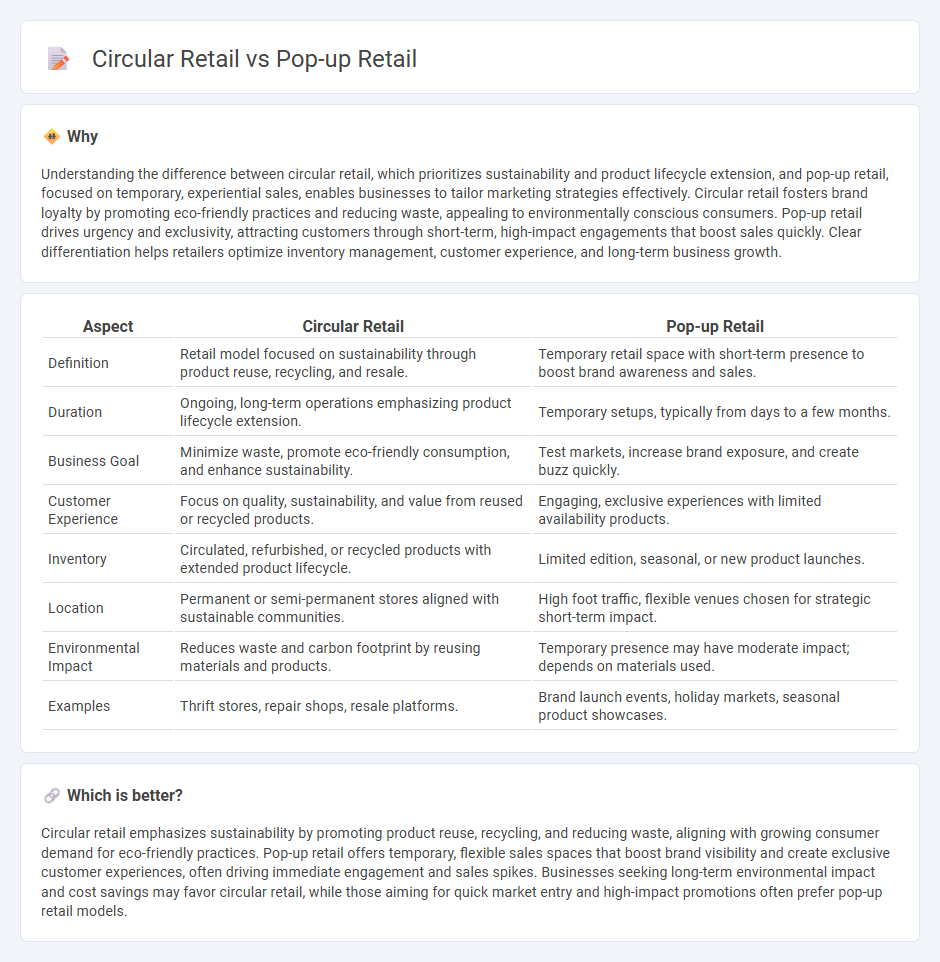
Circular retail emphasizes sustainability by encouraging product reuse, recycling, and extended lifecycle, reducing environmental impact through closed-loop systems. Pop-up retail focuses on temporary, location-specific storefronts that create unique shopping experiences and drive short-term consumer engagement. Explore deeper insights into how these retail models transform consumer behavior and business strategies.
Why it is important
Understanding the difference between circular retail, which prioritizes sustainability and product lifecycle extension, and pop-up retail, focused on temporary, experiential sales, enables businesses to tailor marketing strategies effectively. Circular retail fosters brand loyalty by promoting eco-friendly practices and reducing waste, appealing to environmentally conscious consumers. Pop-up retail drives urgency and exclusivity, attracting customers through short-term, high-impact engagements that boost sales quickly. Clear differentiation helps retailers optimize inventory management, customer experience, and long-term business growth.
Comparison Table
| Aspect | Circular Retail | Pop-up Retail |
|---|---|---|
| Definition | Retail model focused on sustainability through product reuse, recycling, and resale. | Temporary retail space with short-term presence to boost brand awareness and sales. |
| Duration | Ongoing, long-term operations emphasizing product lifecycle extension. | Temporary setups, typically from days to a few months. |
| Business Goal | Minimize waste, promote eco-friendly consumption, and enhance sustainability. | Test markets, increase brand exposure, and create buzz quickly. |
| Customer Experience | Focus on quality, sustainability, and value from reused or recycled products. | Engaging, exclusive experiences with limited availability products. |
| Inventory | Circulated, refurbished, or recycled products with extended product lifecycle. | Limited edition, seasonal, or new product launches. |
| Location | Permanent or semi-permanent stores aligned with sustainable communities. | High foot traffic, flexible venues chosen for strategic short-term impact. |
| Environmental Impact | Reduces waste and carbon footprint by reusing materials and products. | Temporary presence may have moderate impact; depends on materials used. |
| Examples | Thrift stores, repair shops, resale platforms. | Brand launch events, holiday markets, seasonal product showcases. |
Which is better?
Circular retail emphasizes sustainability by promoting product reuse, recycling, and reducing waste, aligning with growing consumer demand for eco-friendly practices. Pop-up retail offers temporary, flexible sales spaces that boost brand visibility and create exclusive customer experiences, often driving immediate engagement and sales spikes. Businesses seeking long-term environmental impact and cost savings may favor circular retail, while those aiming for quick market entry and high-impact promotions often prefer pop-up retail models.
Connection
Circular retail and pop-up retail are connected through their emphasis on sustainability and consumer engagement. Circular retail promotes the reuse, recycling, and upcycling of products, while pop-up retail offers temporary, flexible spaces that allow brands to test eco-friendly products and create awareness about circular economy principles. Both models drive innovation in reducing waste and enhancing the lifecycle of retail goods.
Key Terms
Temporary Storefronts
Pop-up retail leverages temporary storefronts to create short-term, immersive shopping experiences that drive brand awareness and sales spikes during events or product launches. Circular retail emphasizes sustainability by using temporary stores to promote the reuse, recycling, and resale of products, reducing waste and encouraging eco-friendly consumption patterns. Explore how these innovative retail models reshape consumer engagement and environmental impact through transient storefront strategies.
Product Lifecycle
Pop-up retail shortens the product lifecycle by creating temporary, seasonal demand that drives immediate sales and rapid inventory turnover, often emphasizing limited-edition or trend-driven products. Circular retail extends the product lifecycle through sustainable practices such as refurbishing, reselling, and recycling, fostering a closed-loop system that reduces waste and promotes resource efficiency. Explore how evolving retail models reshape consumption patterns and sustainability strategies.
Sustainability
Pop-up retail offers temporary, flexible shopping experiences that reduce long-term resource consumption and waste associated with permanent store operations, aligning with sustainable business practices. Circular retail emphasizes product life extension through reuse, refurbishment, and recycling, minimizing environmental impact and supporting a closed-loop economy. Explore how businesses integrate these models to enhance sustainability and consumer engagement.
Source and External Links
What Is Pop-Up Retail? - StoreForce - Pop-up retail refers to short-term sales spaces designed to create unique customer experiences, often appearing in flexible, high-traffic locations for limited durations, aiming to generate excitement or test new markets without a permanent lease commitment.
Pop-up retail - Wikipedia - Pop-up retail is a temporary retail trend where stores 'pop up' for a limited time to build product interest, offer seasonal items, test markets, or create engagement, used globally including seasonal or event-based sales.
What Is a Pop-Up Shop? Definition, Benefits and Costs (2025) - Pop-up shops provide benefits such as creating personal customer connections, generating buzz through scarcity marketing, testing physical retail locations, and clearing older inventory with lower upfront costs.
 dowidth.com
dowidth.com